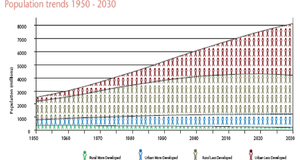Arsenic Contamination of Groundwater in Nepal: Good Public Health Intention Gone Bad
By
2012, Vol. 4 No. 09 | pg. 3/3 | « What Remains to be Done?Studies have revealed the gravity of arsenic contamination of groundwater in Terai region of Nepal. About 20,000 shallow wells equipped with hand pumps have been tested to date, out of a total of 200,000.37 Testing of all wells across the Terai Region is needed to systematically identify the magnitude of the problem. It has been found that geological source for the Bengal and Indus Basins as for Terai region of Nepal, primarily originated in the Himalayas. Therefore, more comprehensive hydro-geological investigation needs to be conducted to identify arsenic spatial distribution pattern throughout the country and pattern of arsenic mobilization in groundwater in Terai. It will help to identify risk area and at the same time will help to prepare guideline for future tube well installation, and preventive/mitigation strategy.37 The tube wells and other water sources, soil and sediments, various food items needs to be monitor regularly. There is an urgent need to develop an effective national strategy for modernizing the irrigation system and improving management and performance of the surface irrigation systems in Nepal, with regard to the vulnerability of the areas with respect to arsenic contamination. Training program for health personnel from Terai district should be launched so that they will be able to deal with the arsenicosis patient. A special course on arsenic should be designed in medical, public health, engineering, and other relevant academic institutions. More operational research is needed to recommend appropriate arsenic removal technique at small communities and household level. Government needs to work on to standardize and strengthen groundwater quality sampling and analytical procedures (with emphasis on arsenic), and to consolidate the existing groundwater agencies under a national regulatory body, to draft legal provisions on groundwater, and to incorporate them into the Water Resources Act.38 The collaboration among various stakeholders working in arsenic related project must be established for uniform dissemination of information and advocacy. Discussion and ConclusionsLately, issue of arsenic contamination of ground drinking water has been a predominant phenomenon in Terai region of Nepal. Mitigation procedures must be employed as soon as arsenic has been identified. While the success of implementation depends mainly on socioeconomic factors as well as people's acceptance of an option and its capital cost, scientific understanding of arsenic has enhanced value on the quantification of impacts, but not on the implementation of mitigation measures. Therefore, instead of delaying implementation until arsenic contamination is fully understood, both implementation and scientific investigation should be conducted in parallel.At the policy level, when arsenic contamination is identified in groundwater there is a need to assess the scale of contamination and the emergency level based on the population at risk, the time of exposure, and the concentration of arsenic in water. Based on the contamination scale and the emergency level, government should implement a regional emergency plan of action with short-term and long-term components to mitigate arsenic contamination. Potential emergency and short-term responses include dug wells, pond sand filters, rainwater harvesting, arsenic removal filters at the household level, and use of a safe aquifer. Potential long-term operational responses are arsenic removal plants at the community level, piped water supply, and use of a safe aquifer. At the implementation level, when arsenic is identified, there is a need to ensure the appropriate government institution about the contamination, ensure that the data are available to public and all stakeholders and properly stored for further scientific research and ensure that the government requires the private operator to check arsenic on a regular basis and makes the results available to stakeholder. Health and socio-economic problems associated with it appear to be in an acute and unmanageable state in the southwestern part of Nepal. Ignorance, illiteracy as well as lack of access to basic infrastructure have added further complication to the problem. With a growing population, increasing industrialization, and higher demands for good quality water, these problems will get worse in the decades to come if no mitigation steps are taken right now. Identification of arsenic-affected areas and provision of safe, alternative water supply options in the affected regions are needed to combat the arsenic problem. There is an urgent need for mass international involvement and participation of the private, government, and industrial sectors in addressing the problems is urgently needed to take united, immediate and effective steps to save millions of people in Nepal. References(1) Pahari K, Malla P. Analysis and Mapping of Arsenic in Ground Water of Terai region in Nepal. 2007; Available at: http://www.humeco.m.u-tokyo.ac.jp/envr_p/working_paper/PAHARI_NepalArsenic.pdf. Accessed March 24. (2) CIA. The World Factbook: Nepal. 2012; Available at: https://www.cia.gov/library/publications/the-world-factbook/geos/np.html. Accessed March 24, 2012. (3) Shing WW. AHRC Letter: Nepal: Government Should Prioritize Dalits' Food Security. 2011; Available at: http://idsn.org/news-resources/idsn-news/read/article/ahrc-letter-nepal-government-should-give-prioritize-dalits-food-security/128/. Accessed March 24, 2012. (4) M. Patricia Halsey. Arsenic Contamination Study of Drinking Water in Nepal [dissertation]. MA, USA: Massachusetts Institute of Technology; 2000. (5) Shrestha RR, Shrestha MP, Upadhyay NP, Pradhan R, Khadka R, Maskey A, et al. Groundwater arsenic contamination, its health impact and mitigation program in Nepal. J.Environ.Sci.Health.A.Tox.Hazard.Subst.Environ.Eng. 2003 Jan;38(1):185-200. (6) Panthi RS, Sharma S, Mishra KA. Recent Status of Arsenic Contamination in Groundwater of Nepal-A Review. Kathmandu University Journal of Science, Engineering and Technology 2006;2(1):1-11. (7) Meharg A. Venomous Earch: How Arsenic Caused the World's World Mass Poisoning. UK: Palgrave Macmillan; 2005. (8) Arsenic Exposure-Carcinogen. 2011; Available at: http://www.sos-arsenic.net/english/contamin/index.html. Accessed March 25, 2012. (9) Mandal BK, Suzuki KT. Arsenic round the world: a review. Talanta 2002 Aug 16;58(1):201-235. (10) Yadav I,C., Dhuldhaj U,P., Mohan ,Devendra, Singh ,Surendra. Current status of groundwater arsenic and its impacts on health and mitigation measures in the Terai basin of Nepal: An overview. Environmental Reviews 2011;19(1): 55-67. (11) Greenfacts. Scientific Facts on Arsenic. 2004; Available at: http://www.greenfacts.org/en/arsenic/index.htm. Accessed March 24, 2012. (12) Adamsen RK, Pokharel A. The Arsenic Contamination of the Drinking Water in Nepal. 2002; Available at: http://www.bvsde.ops-oms.org/bvsacd/arsenico/nepal.pdf. Accessed March 24, 2012. (13) Jusoh WN, Rosli F. Industrial and Environmental Toxciology. 2009; Available at: http://www.scribd.com/doc/52159878/ARSENIC-full-report-APAD-DAYAT. Accessed March 25, 2012. (14) Saha JC, Dikshit AK, Bandyopadhyay M, Saha KC. A Review of Arsenic Poisoning and Its Effects on Human Health. Critical Reviews in Environmental Science and Technology 1999;29(3):281-313. (15) N.Linthoingambi D, Yadav CI, Qi S. Recent Status of Arsenic Contamination in Groundwater of Northeastern India-A Review. Report and Opinion 2009;1(3):22-32. (16) Ghimire VL. Arsenic Poisoning in Nepal. 2005; Available at: http://www.jyi.org/letters/l2e.php?id=260. Accessed March 27, 2012. (17) IRIN Asia. Nepal: Increasing use of filters for arsenic-contaminated water. 2010; Available at: http://www.irinnews.org/Report/90406/NEPAL-Increasing-use-of-filters-for-arsenic-contaminated-water. Accessed March 27, 2012. (18) DWSS. Summary of Known Arsenic Occurrence in Groundwater in Nepal. DWSS Report 2004. (19) Maharjan M, Shrestha RR, Ahmad SA, Watanabe C, Ohtsuka R. Prevalence of arsenicosis in terai, Nepal. J.Health Popul.Nutr. 2006 Jun;24(2):246-252. (20) Pokhrel D, Bhandari BS, Viraraghavan T. Arsenic contamination of groundwater in the Terai region of Nepal: an overview of health concerns and treatment options. Environ.Int. 2009 Jan;35(1):157-161. (21) Fewtrell L, Fuge R, Kay D. An estimation of the global burden of disease due to skin lesions caused by arsenic in drinking water. J.Water.Health. 2005 Jun;3(2):101-107. (22) Ruffino V. Arsenic: Environmental Chemical. 2010; Available at: http://flipper.diff.org/app/items/info/2978. Accessed March 25, 2012. (23) Kalia K, Flora SJ. Strategies for safe and effective therapeutic measures for chronic arsenic and lead poisoning. J.Occup.Health. 2005 Jan;47(1):1-21. (24) Mazumder ZD. Diagnosis and treatment of chronic arsenic poisoning. 2000; Available at: http://www.who.int/water_sanitation_health/dwq/arsenicun4.pdf. Accessed March 25, 2012. (25) Wang J,Shaofen, Wai C,M. Arsenic in drinking water - A global environmental problem. J.Chem. Educ. 2004 Feb;81(2):207-213. (26) Appelo T, editor. Arsenic in Groundwater - A World Problem. Geochemical Experimentation and Modelling are Tools for Understanding the Origin of Arsenic in Groundwater in Bangladesh and Elsewhere; November 29; Utrecht, Netherlands: International Association of Hydrogeologists; 2006. (27) Thakur JK, Thakur RK, Ramanathan A, Kumar M, Singh SK. Arsenic Contamination of Groundwater in Nepal—An Overview. Water 2010;3(1):1-20. (28) Kohnhorst A. Arsenic in Groundwater in Selected Countries in South and Southeast Asia: A Review. The journal of Tropical Medicine and Parasitology 2005;28(2):73-82. (29) Mukherjee A, Sengupta MK, Hossain MA, Ahamed S, Das B, Nayak B, et al. Arsenic contamination in groundwater: a global perspective with emphasis on the Asian scenario. J.Health Popul.Nutr. 2006 Jun;24(2):142-163. (30) Maskey A, Shrestha R, editors. Sixth Water Information Summit: Breaking the Barriers Let Water Information Flow! Arsenic Infromation Center- An Approach for Raising Awareness to Grass Root Communities of Nepal ; Sept 9-12; Delft, The Netherlands: Waterweb Consortium and IRC International Water and Sanitation Centre; 2003. (31) ENPHO. Arsenic Mitigation Programme. 2010; Available at: http://www.enpho.org/programs/25-programs/safe-water/67.html. Accessed March 25, 2012. (32) Nepal DG. Research on Mitigation options of Arsenic contaminated Groundwater in Nepal. Rural Water Supply and Sanitation Project, Western Nepal 2011;2012(March 24). (33) Frey S, Kang C, Lucchine D, Ueno D. KanchanTM Arsenic Filter (KAF) Implementation and Enhancement. GLAB Final Report 2006. (34) Brinkel J, Khan MH, Kraemer A. A systematic review of arsenic exposure and its social and mental health effects with special reference to Bangladesh. Int.J.Environ.Res.Public.Health. 2009 May;6(5):1609-1619. (35) Adhikari HJ. Socio-economic Status of Arsenicosis Symptomatic Patients in Santpur, Rautahat, Nepal. J Epidemiol Community Health 2005;3(2):17-22. (36) Ahmad SA, Sayed MH, Khan MH, Karim MN, Haque MA, Bhuiyan MS, et al. Sociocultural aspects of arsenicosis in Bangladesh: community perspective. J.Environ.Sci.Health.A.Tox.Hazard.Subst.Environ.Eng. 2007 Oct;42(12):1945-1958. (37) Chappell RW, Abernaty CO, Calderon RL. Arsenic Exposure and Health Effects V. Arsenic Exposure and Health Effects V ed. MO, USA: Elsevier Science & Technology; 2004. (38) Tuinhof A, Nanni M. Nepal: Approach to Mitigation of Groundwater Arsenic Contamination Including New Groundwater Legislation. Case Profile Collection 2004;12:1-7. Suggested Reading from Inquiries Journal
Inquiries Journal provides undergraduate and graduate students around the world a platform for the wide dissemination of academic work over a range of core disciplines. Representing the work of students from hundreds of institutions around the globe, Inquiries Journal's large database of academic articles is completely free. Learn more | Blog | Submit Latest in Health Science |


















